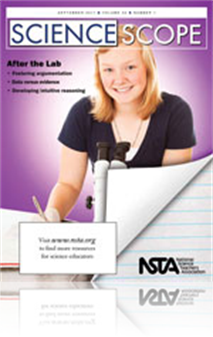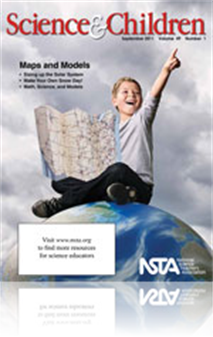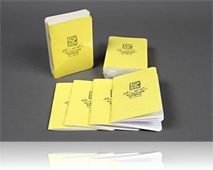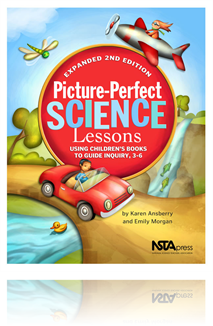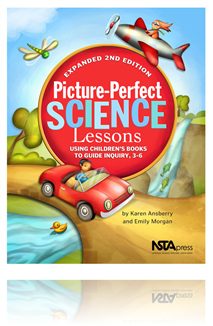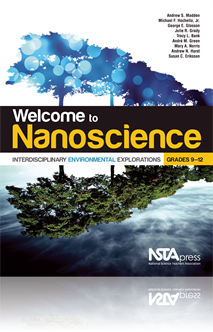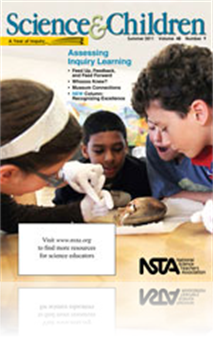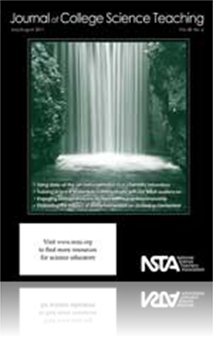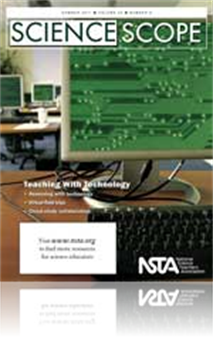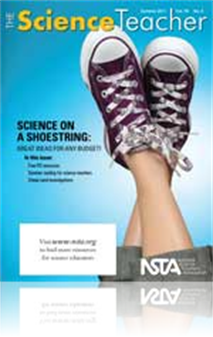All Resources
Journal Article
Favorite Demonstration: Visual Aid to Demonstrate Change of State and Gas Pressure With Temperature
The visual aid described in this article is designed to demonstrate the change in state of matter with the change of temperature and the change of pressure with temperature....
Journal Article
The Early Years: A Sense of Place
This column discusses resources and science topics related to students in grades preK to 2. In this month’s issue students learn to use the school yard as a model....
Journal Article
Guest Editorial: Minds, Models, and Maps
An opinion piece about the benefits of visual learning devices....
Journal Article
The Green Room: International Sustainability Education
This column focuses on making your teaching more environmentally friendly. In this month’s issue, the author discusses three sustainability stories of three schools she visited in the past year....
Journal Article
Developing Intuitive Reasoning With Graphs to Support Science Arguments
This article describes two activities—one math activity and one science activity—that teach students how to make a scientific argument and articulate a scientific claim. ...
Journal Article
Research and Teaching: Undergraduate Research Experiences From a Longitudinal Perspective
The purpose of this study was to investigate the educational enhancements of undergraduate research experiences participation from the perspective of practicing scientists in chemistry and physics....
Journal Article
Introducing <i>A Framework for K–12 Science Education</i>: A Message to Our Members
The author gives an overview of the National Research Council's newly released A Framework for K–12 Science Education....
Journal Article
Formative Assessment Probes: Where Are the Stars?
This column focuses on promoting learning through assessment. In this month’s issue the author explores children's knowledge of where the stars are in relation to the Earth and Moon....
Journal Article
Use recent Hollywood movies to generate interest in your science classroom. Movie clips can provide data for content-rich problem solving, show students exotic phenomena, allow them to apply science concepts in a new setting and foster connections be...
Class Pack
Outdoor Science Field Journals (Five Pack) ClassPack
Using Outdoor Science in your classroom is easier than ever! NSTA’s ClassPacks are an unmatched time-saver and a great deal. The 28-page, waterproof, pocket-size Field Journals encourage students to record all of their observations of the outdoor w...
eBook
Winner of the Bronze EXCEL Award from Association Media & Publishing!How do you improve upon perfection? For years, new and experienced elementary school teachers alike have extolled the virtues of Picture-Perfect Science Lessons—the expertly combi...
Book Chapter
Brainstorms: From Idea to Invention
Learners explore the design process by improving an existing invention; designing and building a drink holder for an airplane seat and communicating their design process; and designing an investigation to evaluate Scotchgard. For more information on...
Book Chapter
Using a model, learners explore time zones and what causes day and night and how time zones change. Learners observed the position of the Sun in the sky at different times of day and relate those positions to the rotation of the Earth. For more info...
Book Chapter
Learners make drawing of what they think might be inside “energy balls,” small plastic spheres that light up and buzz. After investigating simple circuits using batteries, bulbs, and wires, they learn that electricity needs a complete loop to flo...
Book Chapter
Learners keep track of their households’ water use for one day, explore ways to conserve water and then create a Water Watch campaign for school or home. They also discover that clean water is limited in many places on Earth and learn about how wat...
Book Chapter
Learners explore how sound is produced by vibrations. They make a straw instrument and investigate how to vary its pitch. Learns also design and build an instrument that produces a high pitch and a low pitch and explain how it works. For more inform...
Book Chapter
Learners explore the differences between chemical and physical changes by observing a variety of changes in mater. Learners observe the chemical change of cooking pancakes and identify new menu items for the Chemical Change Café. For more informati...
Book Chapter
In this chapter, you will learn how experiments are structured. This structure or experimental setup is called the research design. The research design of an experiment determines both whether the experiment is likely to succeed and the reliability ...
Book Chapter
Close Encounters of the Symbiotic Kind
Learners explore how some organisms interact with other organisms through symbiotic relationships by observing “mystery objects” (plant galls) collected from the local ecosystem. For more information on how to implement Picture-Perfect Science in...
Book Chapter
By taking part in a simulation, learners explore the many threats to sea turtles and the ways humans can help them survive. Learns identify which dangers result from human actions and which dangers are natural. Learners also explore the life cycles o...
Book Chapter
Learners explore the importance of rice as a food source, the differences among types of rice, the life cycle of rice, and rice production methods. Learners also explore control, variables, and experimental design by investigation how rice grows and ...
Book Chapter
Nano2Earth Curriculum and the National Science Education Standards
With the Nano2Earth curriculum, students learn about nanotechnology and nanoscience by using inquiry to study groundwater pollution. The curriculum is designed to meet the National Science Education Standards (NSES) for content in grades 9–12 (NRC ...
Journal Article
Leaders at a nature museum share their knowledge of how to structure a learning environment to guide children's development of science skills. They also created a classroom self-assessment tool for early childhood and early elementary educators to us...
Journal Article
Science and Me: A Student-Driven Science Outreach Program for Lay Adult Audiences
The increasing need for communicating science to the public suggests that future scientists and science educators should be educated in science outreach and trained to communicate with lay audiences. We present a recently developed novel graduate cou...
Journal Article
A Field Trip Without Buses: Connecting Your Students to Scientists Through a Virtual Visit
One school offers zipTrips as an alternative to actual field trips taken outside of school. ZipTrips are web- and broadcast-delivered electronic field trips that include online videos; lesson plans; and a live, 45-minute interactive program consistin...
Journal Article
Shifting to an Inquiry-Based Experience
The authors provide a prescriptive, step-by-step method to convert a cookbook lab into an inquiry-based science experience....
Journal Article
Idea Bank: Nature as Learning Tool
The Idea Bank provides tips and techniques for creative teaching, in about 1,000 words. In this month’s Idea Bank, the author discusses how to draw on students' firsthand experiences to help them develop an appreciation for nature and its historica...
Journal Article
Current Research: 2011 Summer Reading Suggestions
A list of science education research articles compiled by NSTA's Committee on Research in Science Education, the Association for Science Teacher Education, the National Association for Research in Science Teaching, and the National Science Education ...
Journal Article
Editor's Corner: Tough Times for Teachers
The Science Teacher’s editor shares thoughts on the current issue....
Journal Article
Career of the Month: Environmental Advocate
This column shares interviews with professionals using science in the workplace. In this month’s issue, Shereen Hughes is interviewed about her work as an environmental advocate....
Journal Article
Point of View: Teaching Good Writing, Why Bother?
An opinion piece about whether teachers of science should teach writing....
Journal Article
Formative Assessment Probes: With a Purpose
This column focuses on promoting learning through assessment. In this month’s issue the author uses the stages of the SAIL Cycle to reflect upon and share some of the ways the probes published in Science and Children (2010-2011) can be used to inte...
Journal Article
Cloud Study Investigators: Using NASA's CERES S'COOL in Problem-Based Learning
During a problem-based learning activity, middle school students conduct authentic scientific research by observing and recording information about clouds and contribute ground truth data to NASA's Clouds and the Earth's Radiant Energy System (CERES)...
Journal Article
Research and Teaching: Designing a Blended Course: Using ADDIE to Guide Instructional Design
The ADDIE (analysis, design, development, implementation, and evaluation) model was applied to help redesign a General Chemistry course to improve student success in the course. The resultant course is a blend of online and face-to-face instruction t...




